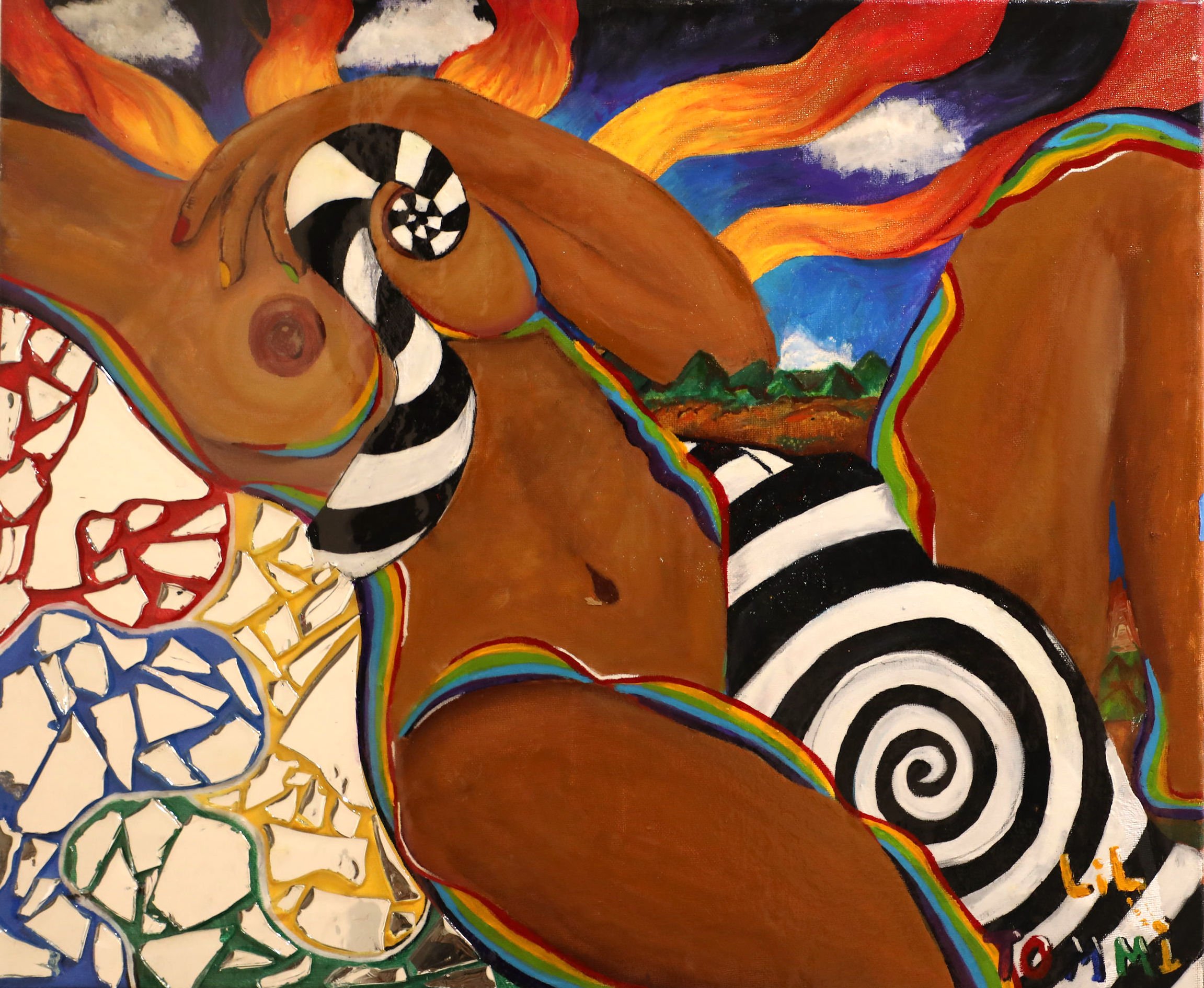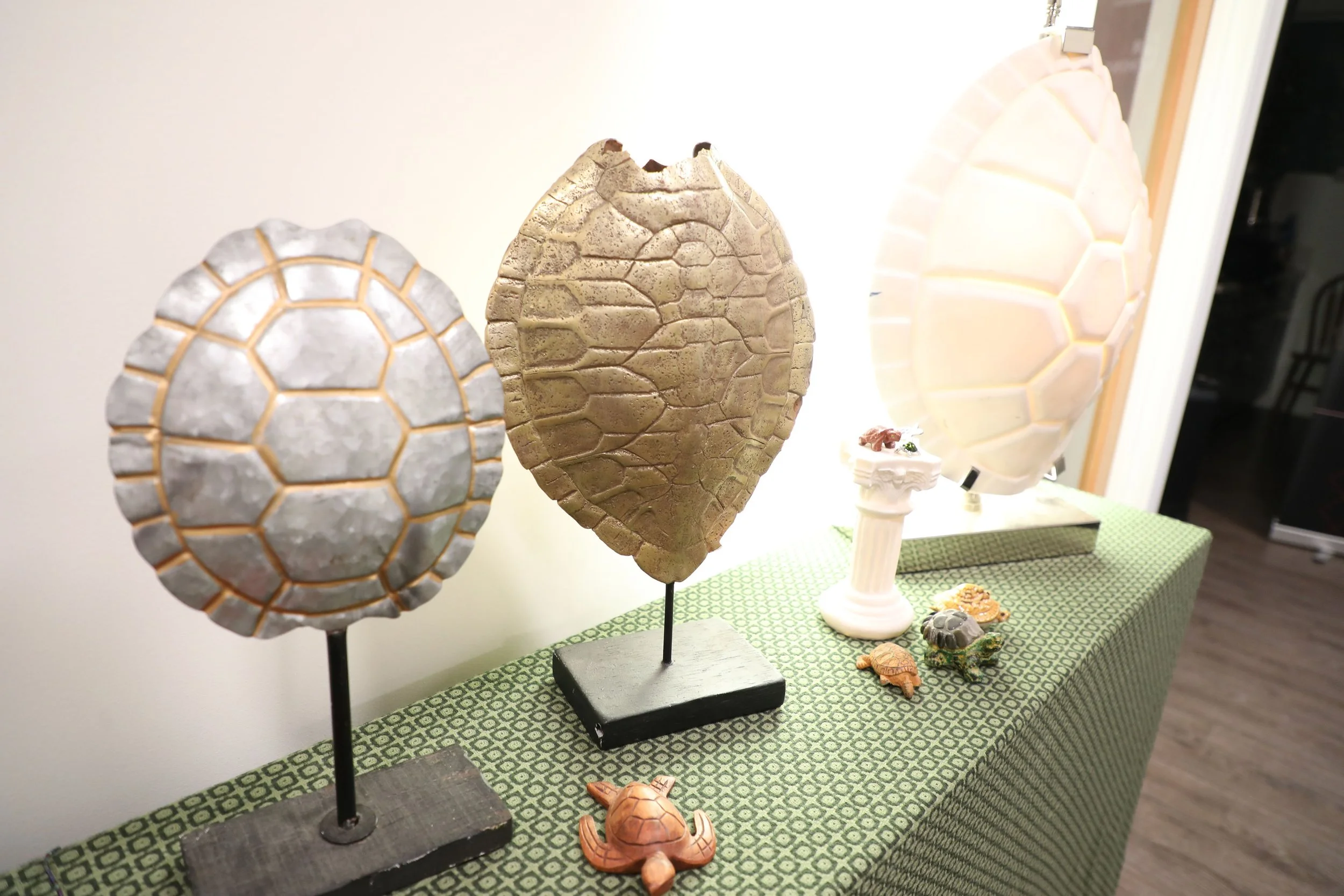An Interview with Raegan Brown
WITH Leslie FOSTER
Images by Helenna Santos & Tina June Malek
Leslie Foster: Just to jump right in, I’d love to ask you about your art origin story. Why art? What sparked your initial interest and how did it grow?
Raegan Brown: Expressing myself through creation and building has always been a part of my DNA. During my childhood, I would watch my mother use her vast artistic skills in numerous ways. She was a gifted interior designer, prop-building master – using upcycled materials, and a natural at scene design – constructing intricate sets for church and family events. I would often accompany her during her creative projects and assist in any way that I could. I became fascinated with the art of transforming something that appeared insignificant into something extraordinary and beautiful.
On the other hand, my father had an affinity for electronics and was a collector of various technological oddities that I would discover around the house. He would offer me his old computers, without internet access, and I found ways to entertain myself. Every new electronic device was a puzzle to take apart and put back together, and I started building my own computers and fixing phones at a young age. Both aspects of expression became creative outlets for me.
As I grew older, I pursued my passions for art and technology in different ways and became heavily involved in creative extracurricular activities while also pursuing my computer science academic career. However, I began to feel that these two interests couldn't coexist within my attention span, and I could only focus on one at a time. I would either be highly invested in the arts but struggle academically, or be completely invested in my academics and neglect my creative pursuits.
To integrate my love for both fields, I started exploring ways to bridge the gap between art and technology. It was a personal journey that led me to the immersive industry, where I now teach immersive readiness in the community. Through my work, I hope to provide an avenue for access to immersive fields and want to share my passion for creative technology with others.
“Creating for the sake of creating, rather than for display or an end product, has become an essential part of my artistic process.”
LF: Your identity plays such an important and beautiful role in your work. How do you conceptualize your identities and how do you see them manifesting in your work as an artist?
RB: Since the show, I have experienced a significant revelation about my identity and how it presents itself. During and leading up to the show, I referred to myself by my artist name, Tommi. However, immediately after the show, I was almost repelled by the name and began embracing my given name, Raegan, again. I have a theory about this, which is deeply connected to my healing journey. Especially after the pandemic, I began feeling a disconnection in my identity, which was a significant theme in my show. I felt like different versions of my identity expressed themselves very distinctly. Ultimately, I was diagnosed with bipolar disorder, which helped me understand my experience. During the show and the time leading up to it, I was constantly evolving and learning more about myself, which was overwhelming. Creating a show revolving around oneself and one's life can be healing, but it can also trigger traumatic feelings, which I was constantly dealing with. I was also attempting to avoid those parts of myself, which made it even more challenging to create, especially under pressure. I felt like I was in a constant state of hypomania, and my inner child manifested as the Tommi character because they needed to be seen. My work became childlike, with bright colors, beautiful chaos, and playfulness. I experimented with no real plan, and sometimes my creativity surpassed my bandwidth. I think the night of my show was the first time Tommi finally felt seen. After that night, my identity manifested itself in my work in a more integrated and confident manner. I am now more open to learning new things and being a beginner, while also being content with imperfection and not always achieving what I initially envisioned. Creating for the sake of creating, rather than for display or an end product, has become an essential part of my artistic process.
“It feels like I am embarking on a journey
that aligns with my purpose.”
LF: I love that you have an endless energy for exploration and adding new skills to your artistic toolkit! What mediums are you currently exploring and how do you see them adding to your work now and in the future?
RB: I am jumping into my technical bag right now and expanding my love for working in virtual worlds. I am immersing myself in learning a new skill: virtual production. Although I started using Unreal Engine to create short animated films, I am now exploring the world of filmmaking and how to use this software to merge physical and virtual worlds in cinematography. I have been exploring motion capture, green screen composition, and many other aspects of filmmaking. It feels like I am embarking on a journey that aligns with my purpose. My hope is that by mastering these creative and technical skills, I can teach other underrepresented individuals in this field and demonstrate new avenues of creativity. Seeing my projects come to life has been extremely rewarding, and I am excited to continue growing in this space.
LF: Your work is deeply personal and can often be quite vulnerable. What does it feel like to converse and wrestle with your own narrative in public?
RB: When I first began discovering parts of myself, it was initially overwhelming. When you start going to therapy and your therapist is reading you intensely, it can feel like information overload. You begin to understand why you did certain things when you were younger and how it has affected the rest of your life. To experience this feeling while dealing with it in front of a room full of your peers can be overwhelming. Initially, it was tough when people asked me questions that I didn't necessarily have the answers to about my work and my story. However, as I continue to grow as an artist, it has become much easier. I have come to recognize that although I am not just my past, my past experiences have contributed to who I am today. I am also my future, and I have control over how I let both my past and the people around me who know my inner thoughts affect me. It has been an empowering experience. Some parts of my narrative shock people, and it has been interesting to me that I am nonchalant about them. It's almost as if I have found peace in those experiences, both good and bad, through vulnerability. I am definitely okay with that.
“By sharing my experiences openly, I hope to empower others to feel comfortable in sharing their own unique stories.”
LF: As a follow-up to that question, what do you think is the benefit of that public exploration of self?
RB: My story is unique because I represent the multifaceted nature of Black women, who excel in both artistic and technical fields while dealing with the adversities of life and I do so out loud. One of the major benefits of this public exploration of self has been providing a sense of relatability to many people who share any aspect of my story. By sharing my experiences openly, I hope to empower others to feel comfortable in sharing their own unique stories. It's been heartening to see that my show has resonated with quite a few people who have experienced some of the main themes that it presented. Some of those things, like addiction, are hard for people to talk about, but being so open about my struggles can potentially make space for someone to speak out on their experiences. I believe that by providing this space, I can help others feel seen, heard, and validated, and that's a powerful thing.
LF: How do you see the work you did at Level Ground informing how you approach your artistic practice in this next year or so?
RB: PLAN. In all honesty, I feel like I could have done so much more with my show. While I loved it and was grateful for how it turned out in the end, it could have run much smoother. Since I had never put on a show before, I didn't realize what it really took to make one happen. However, I learned a lot from that experience. Nowadays, I focus much more on planning. I make sure to understand what resources are needed, write down potential roadblocks, and consider different means of achieving my goals. I also allow myself to lean on others when needed. In the past, I used to be very impulsive when creating, just doing things and thinking about them later. But after going through multiple failed attempts, I realized that this wasn't an efficient way of working. Now, I tend to take things more gradually when creating, not rushing myself so that I can perfect the things that are important to me. Although I still appreciate my joy for experimenting, I approach it with a little more wisdom and focus on proper execution.
LF: What has you feeling most excited about art-making in this current moment?
RB: I feel like I've reached a point in my artistic career where I'm comfortable and confident enough to try experimenting with new mediums. It's such a liberating experience to be able to explore my creativity without feeling the pressure to conform to certain expectations or standards. By being open to new experiences and not worrying too much about the final outcome, I'm allowing myself the freedom to take risks and potentially discover new techniques and processes that can
enrich my artistic practice. This kind of experimentation is crucial for my growth as an artist and as a person. I believe in embracing this mindset of creative exploration and not being afraid to try new things, even if they don't turn out the way I expect. Maintaining an open and curious attitude allows me to keep pushing myself creatively and discover new avenues of expression that I may not have considered before.
You can support Raegan’s creative and technology based endeavors by following her on social media!





